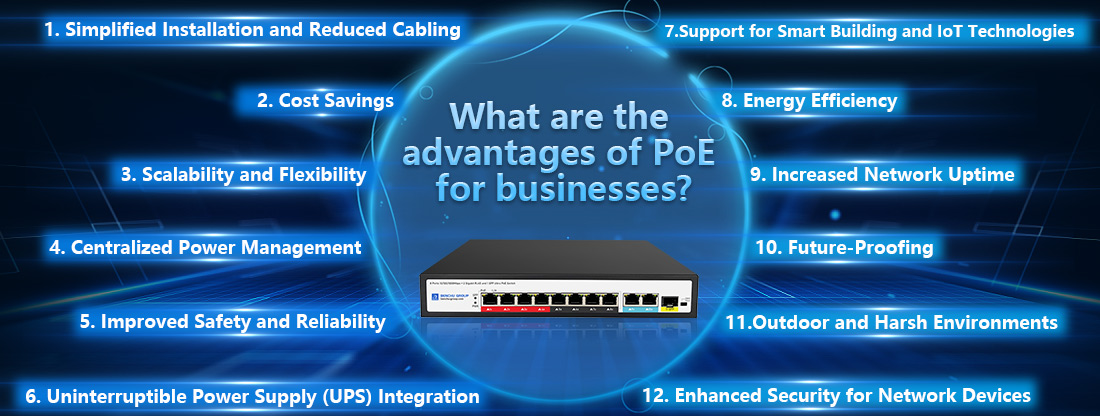
Power over Ethernet (PoE) technology offers several advantages for businesses across various industries, helping to improve network infrastructure, reduce costs, and streamline operations. Here are the key benefits of PoE for businesses:
1. Simplified Installation and Reduced Cabling
Single Cable for Power and Data: PoE allows both power and data to be transmitted over a single Ethernet cable, eliminating the need for separate power cables and outlets. This simplifies installation, especially in hard-to-reach areas like ceilings or outdoor locations.
Flexibility in Device Placement: Devices like wireless access points, IP cameras, and VoIP phones can be placed wherever network cabling can reach, without being constrained by the location of electrical outlets.
2. Cost Savings
Lower Installation Costs: Businesses save on the cost of hiring electricians to run separate power lines. PoE uses existing Ethernet cables, which can be installed by network technicians without specialized electrical knowledge.
Reduced Infrastructure Complexity: Fewer cables and power outlets mean less physical infrastructure, leading to cleaner installations and fewer maintenance requirements.
3. Scalability and Flexibility
Easy Expansion: Adding new devices like cameras, access points, or phones to a network is easier and faster with PoE, as you don’t need to install additional power infrastructure. Devices can simply be plugged into an available PoE port on a switch.
Support for Diverse Devices: PoE can power a wide range of devices, including security cameras, IP phones, wireless access points, IoT sensors, and even LED lighting, making it versatile for growing businesses.
4. Centralized Power Management
Simplified Power Control: PoE allows businesses to manage the power supply of all connected devices from a central location, typically through a PoE switch. This makes it easier to monitor, troubleshoot, and manage the power distribution across the network.
Remote Power Cycling: Many PoE switches support remote power cycling, allowing IT administrators to reset devices (like access points or cameras) without having to physically unplug them. This reduces downtime and improves operational efficiency.
5. Improved Safety and Reliability
Low Voltage Operation: PoE operates at safe, low voltage levels (typically 44-57V DC), reducing the risk of electrical hazards. This makes installation safer, especially in environments where safety is a concern.
Built-in Power Protection: PoE equipment includes mechanisms to detect and protect devices from overloading, underpowering, or receiving power when not needed. This enhances overall network reliability.
6. Uninterruptible Power Supply (UPS) Integration
Continuous Power During Outages: By connecting PoE switches to a centralized Uninterruptible Power Supply (UPS), businesses can ensure continuous power to critical devices such as security cameras, VoIP phones, and wireless access points during power outages. This provides better business continuity and enhances security.
Reduced Downtime: Since PoE-powered devices can rely on a UPS, they remain operational during brief power interruptions, minimizing disruption to network services.
7. Energy Efficiency
Optimized Power Usage: PoE technology is designed to deliver only the power needed by the connected device. This results in lower power consumption, which can reduce operational costs over time.
Green Networking Solutions: Businesses focused on sustainability can use PoE to implement energy-efficient networking solutions, such as LED lighting systems or smart building sensors, which further optimize power usage.
8. Support for Smart Building and IoT Technologies
Smart Building Integration: PoE is integral to smart building infrastructures, enabling devices like environmental sensors, IP cameras, smart lighting, and access control systems to be easily powered and controlled over the network.
IoT Device Connectivity: As businesses adopt Internet of Things (IoT) technologies, PoE provides a scalable solution to power a wide array of connected devices, simplifying the deployment of smart offices and industrial automation systems.
9. Increased Network Uptime
Fewer Points of Failure: PoE minimizes the need for external power adapters and reduces the number of potential points of failure in the network. Devices can be powered directly from the network infrastructure, improving uptime and reducing troubleshooting complexity.
Centralized Troubleshooting: With PoE switches, IT teams can monitor power consumption and quickly identify issues with powered devices remotely, enabling faster diagnosis and resolution of problems.
10. Future-Proofing
Scalable for New Technologies: As businesses grow and adopt new technologies, PoE networks are flexible and scalable, accommodating new devices without the need for significant rewiring or infrastructure upgrades.
Higher Power Capacity: With newer standards like PoE+ (IEEE 802.3at) and PoE++ (IEEE 802.3bt), businesses can support more power-hungry devices like advanced IP cameras, LED lighting, and even digital signage, ensuring compatibility with future tech developments.
11. Enhanced Security for Network Devices
Easier to Secure Devices: Since PoE devices rely on a central switch for power, businesses can secure critical network devices like cameras and access points by ensuring that power is only delivered to trusted devices.
Physical Security Benefits: PoE-powered surveillance cameras and access control systems are easier to deploy in optimal locations, enhancing overall building security.
12. Outdoor and Harsh Environments
Ideal for Remote Locations: PoE is especially useful for powering devices in remote or outdoor locations where electrical outlets are not practical or available, such as security cameras in parking lots or outdoor wireless access points in large campuses.
Environmental Adaptability: Industrial PoE switches are available for harsh environments, allowing businesses in sectors like manufacturing, construction, and transportation to deploy networked devices with robust power delivery.
Conclusion
For businesses, PoE offers a cost-effective, flexible, and scalable solution to deploy network-powered devices efficiently. Whether powering wireless access points, IP cameras, VoIP phones, or smart building technologies, PoE reduces installation complexity, simplifies management, and provides enhanced operational efficiency. These advantages make it a valuable technology for businesses of all sizes.